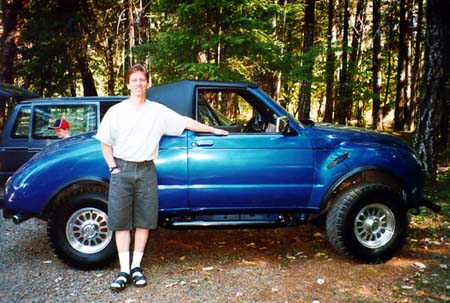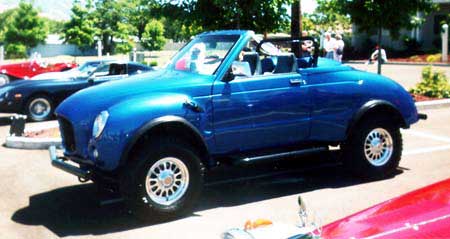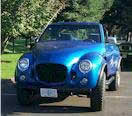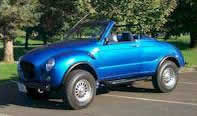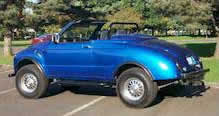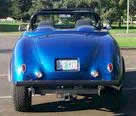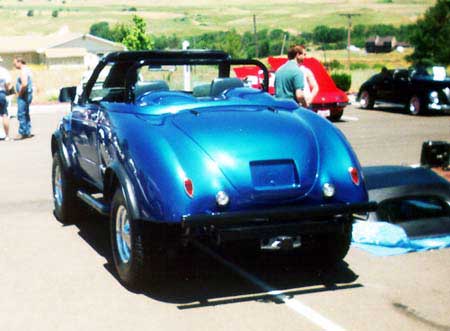Micro Machines Monster Truck
We think Mike Gold's
brother said it best when he came through the doors of Revolution
Vehicle Dynamics, looked at our S-10 Blazer, and said, "That looks like a
Micro Machines monster truck!" With 35-inch Baja Claws sitting under
it, our little Chevy certainly was looking tough.
We decided to
make some drastic changes to our '96 S-10 Blazer last month. The IFS
suspension parts had worn out, the brakes were shot, the steering was
all over the place, and the Almighty Dime had basically been parked
until we could do something.
That “something” ended up being a
solid-axle swap for our mini Blazer. While it would have been nice to
keep the 4WD independent front suspension and done some type of
long-travel kit, we're not aware of any kits currently available, and
the cost of fabricating one would be more than our S-10 is worth (which
is no excuse: We often buy parts worth more than our trucks). A few
people suggested getting rid of the 4WD and putting a 2WD long-travel
kit on, but losing such an advantageous thing like four-wheel drive
seems unreasonable to us. Our Almighty Dime sees more than just desert,
and while it may not be able to go quite as fast off road (with a solid
axle), a four-wheel-drive solid-axle setup will allow us to do
everything we want to do while not being too expensive to boot.
We
did some research, gathered some Wagoneer Dana 44 axles, Wagoneer front
springs, a Sky's Offroad Design SAS (solid-axle swap) hanger kit, and a
few other incidentals we needed to make this all work smoothly. Mike
Gold at Revolution Vehicle Dynamics in Apple Valley, California,
assembled the pieces, built a steering draglink to connect to the
Wagoneer axle's tie rod, and bolted some Rancho Pro Series shocks and
Mickey Thompson 35-inch Baja Claws onto the Almighty Dime. Our mini
Blazer was ready for an initial shakedown run that ended shortly after
realizing how much it wandered.
While the project was moving under its own power, there was (is) definitely still work to do.
Our two real problems were front suspension wandering and front-wheel drive.
After
the first run, there was no question that the SUV needed a front track
bar. Mike fabbed one up and we went back out for another round of
testing, only to tweak the stock front Wagoneer leaf springs. This left
our S-10 sitting low in front and slightly angled to one side. After we
add some new Rancho 44044 Wagoneer front springs, the front should be
back up to the correct height.
As for the front-wheel drive
issue: We ran into a problem we weren't expecting with the long
slip-yoke (not fixed) output shaft on the front of the S-10's NP233C
transfer case. None of our local driveshaft shops could make us a front
driveshaft that would work for our solid-axle swap. The first option we
thought of was to swap the T-case. There are adapters available to put a
few different transfer cases in back of our S-10's 4L60-E transmission,
but our recently rebuilt NP233C is electronically shifted via a dash
knob and already in the truck. Keeping the stock transfer case is
definitely going to be the easiest route, if possible. A little more
S-10 T-case research revealed that there are many similarities between
the NP233C found in S-10s and the NP231J transfer case found in
Cherokees. Other S-10 owners have had success swapping a front output
from a Cherokee T-case into the NP233C, so we're in the process of
tracking down a donor NP231J now.
It is close to done, but the
Almighty Dime project is not quite finished. It's reached a point where
it is stable at 65 mph and can handle prerunning duties with almost no
tire rub. But some better bumpstops, lower gears, and most importantly
four-wheel drive would complete our Almighty Dime.
Step By Step
View Photo Gallery-
1. Our S-10’s solid-axle swap revolves around 1980-and-later Jeep Wagoneer Dana 44 axles. Using them would give us an axle strength upgrade, a brake upgrade, and a suspension that was better suited for off-road use.
-
2. We used a Sky’s Offroad spring hanger kit to get the front Wagoneer axle on. Mike Gold of Revolution Vehicle Dynamics built a rod end draglink to connect to the stock tie rod of the front Dana 44 Wagoneer axle. He reused the original pitman arm on the steering box by modifying it to accept a rod end.
-
3. Since the Wagoneers had all-wheel-drive setups, there were no locking hubs on the front axle we swapped. We added a set of stainless-steel Mile Marker lockout hubs to the Dana 44 to give us 2WD/4WD capability.
-
3. Since the Wagoneers had all-wheel-drive setups, there were no locking hubs on the front axle we swapped. We added a set of stainless-steel Mile Marker lockout hubs to the Dana 44 to give us 2WD/4WD capability.
-
4. To get the rear axle driven by the transfer case, all we had to purchase was a conversion U-joint to get from the original S-10 driveshaft to the swapped-in Dana 44 rear axle. We’ll have to change the driveshaft completely if we decide to do a fixed-yoke kit in the rear of our NP233C transfer case (recommended).
-
5. The front output shaft of our S-10’s NP233C transfer case was causing an issue. The solution is to swap in a front output shaft and yoke from a NP231J Cherokee T-case into our NP233C. As soon as we find a donor NP231J ’case, we’ll get four-wheel drive back.
-
6. Luckily, the Wagoneer axle’s shock mounts lined up in the rear (with the frame mounts) and we easily lined up the fronts since we used Sky’s weld-on Toyota shock hoops. But at ride height, our front 12-inch-stroke Rancho shocks had only a few inches of compression travel. While it was at Revolution Vehicle Dynamics, Mike figured out a solution. He realized he could cut off the front axle’s original shock tabs off the housing and reverse the U-bolt plates from left to right. The Wagoneer U-bolt plates have single-shear studs coming off of them for sway bar link mounts in front of the axle. By turning the U-bolt plates around, Mike effectively made a new lower shock mount that gave us about 2.5 inches more compression travel. While a single shear mount is not ideal, we believe it will be strong enough for this application.
-
6. Luckily, the Wagoneer axle’s shock mounts lined up in the rear (with the frame mounts) and we easily lined up the fronts since we used Sky’s weld-on Toyota shock hoops. But at ride height, our front 12-inch-stroke Rancho shocks had only a few inches of compression travel. While it was at Revolution Vehicle Dynamics, Mike figured out a solution. He realized he could cut off the front axle’s original shock tabs off the housing and reverse the U-bolt plates from left to right. The Wagoneer U-bolt plates have single-shear studs coming off of them for sway bar link mounts in front of the axle. By turning the U-bolt plates around, Mike effectively made a new lower shock mount that gave us about 2.5 inches more compression travel. While a single shear mount is not ideal, we believe it will be strong enough for this application.
-
6. Luckily, the Wagoneer axle’s shock mounts lined up in the rear (with the frame mounts) and we easily lined up the fronts since we used Sky’s weld-on Toyota shock hoops. But at ride height, our front 12-inch-stroke Rancho shocks had only a few inches of compression travel. While it was at Revolution Vehicle Dynamics, Mike figured out a solution. He realized he could cut off the front axle’s original shock tabs off the housing and reverse the U-bolt plates from left to right. The Wagoneer U-bolt plates have single-shear studs coming off of them for sway bar link mounts in front of the axle. By turning the U-bolt plates around, Mike effectively made a new lower shock mount that gave us about 2.5 inches more compression travel. While a single shear mount is not ideal, we believe it will be strong enough for this application.
-
7. After taking its initial shakedown run, the Wagoneer front axle proved to wander too much and was pushed side to side by the steering system. Wagoneers used track bars straight from the factory for this very reason, so our front axle already had a track bar bracket. Mike fabbed up a track bar bracket on the frame and a rod end track bar to match, keeping it parallel with the steering draglink.
-
8. The rear had no issues. We used Sky’s S-10 shackles, the stock S-10 leaf springs, and welded new spring pads to the axle. The upper and lower shock tabs even lined up. With the lift shackles, the stock leaf springs, and the spring-under axle, we were able to put on 315/75R16 (35-inch) Mickey Thompson Baja Claws on Classic III aluminum wheels.
-
9. Wagoneers came with 15-inch wheels, which typically have a higher offset than a 16-inch wheel does. When we went to put on our new 16-inch Classic III wheels, we didn’t get more than a few feet out of the work bay before having to stop for a rubbing noise. The tie rod ends were actually rubbing the 16-inch wheels. We would have gone with a 15-inch wheel, but tires for 15-inch wheels are getting harder to find and 16s opened up tire selection for us.
-
10a. Four G2 Axle & Gear billet wheel spacers solved the issue for us. Not only did it allow clearance of the tie rod ends and wheels, but it also allowed us to clear the front leaf springs at full steering lock. The added 1.25 inches of width to each side brought our track width back to about that of a factory Wagoneer.
-
10b. Four G2 Axle & Gear billet wheel spacers solved the issue for us. Not only did it allow clearance of the tie rod ends and wheels, but it also allowed us to clear the front leaf springs at full steering lock. The added 1.25 inches of width to each side brought our track width back to about that of a factory Wagoneer.
-
11. While we had no front-wheel drive yet, we did make it around as best we could in rear-wheel only. We were definitely impressed with how far the Mickey Thompson Baja Claw radials took us in 2WD.
From: http://www.fourwheeler.com/how-to/transmission-drivetrain/1310-solid-axle-swapping-a-1996-chevy-s10-blazer-the-almighty-dime-part-2/

















